Analysis of the "Martian": technique
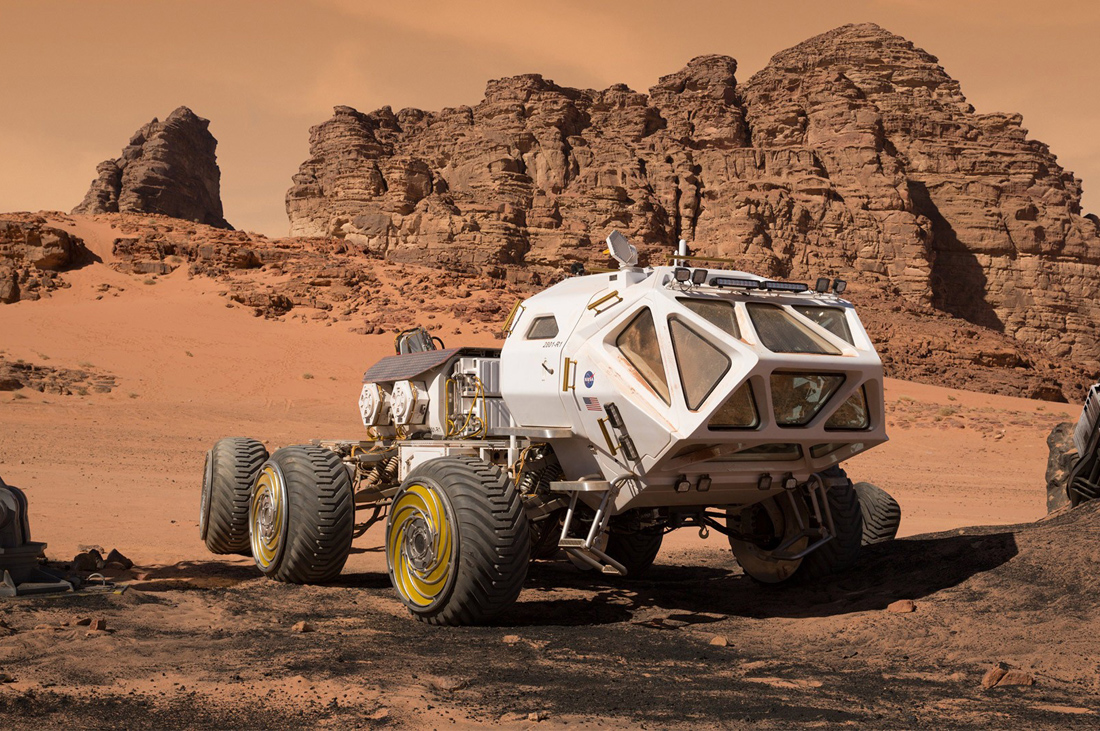
We continue to review the realistic and fantastic in Ridley Scott's Hollywood movie “The Martian.” Yesterday we talked about the fictional and real Mars, science and politics, and today we will consider the technical side of the issue. This is the most fertile topic for comments, searching for mistakes and inaccuracies, since it was the technique that was the main fetish of Andy Weyer - the author of the book.
About spacesuit "Martian" we said.
A few words still have to be said about their homes. They relate to the spacecraft.

There is an idea that terrible radiation reigns on Mars, and if people find themselves there, then they will need to immediately dig into the ground. This view is based on the fact that the atmosphere of Mars is rarefied and allows a lot of cosmic radiation to pass through.
However, studies of the same Curiosity show that in interplanetary space, radiation is not so high as to significantly harm the crew of the spacecraft. According to him, during the flight Earth-Mars-Earth, in a ship of the modern type, the risk of oncology will increase by 5% due to the accumulated radiation dose in humans. According to NASA standards, an astronaut is now written off if he gains 3% during his work. If you increase the thickness of the sides per millimeter of aluminum in the ship, place the fuel and water supplies between the cladding and the living compartments and use other fairly simple means of protection, then you can fly.
On Mars, the atmosphere reduces the radioactive background approximately two times lower than the background inside the interplanetary spaceship of the modern type. Therefore, for a two-three-month expedition, such as Ares-3, the construction of light inflatable residential structures with multi-layer cladding from metallized layers is quite justified. Such an inflatable module is now manufactured by Bigelow Aerospace by order of NASA for the ISS.

There is another controversy surrounding Mark Watney's inflatable house - in working pressure. He first mentions that there is an oxygenated atmosphere. This is only permissible if a low pressure of 30-50% of the earth’s pressure is maintained in the home in order to save on the mass of gases that fill the internal environment. Given this, it is unlikely that a breakthrough in the semi-atmosphere would lead to such a catastrophic explosion that destroyed the Martian base.

Repair of the spacesuit and the base case with adhesive tape is, by the way, one of the most convincing details. Silver tape is actively used in orbit, and more primitive tools may be suitable for repairing space technology.

A rough blunder of the film at the moment when the Martian wind “plays” with a plastic patch. Even if we assume that such a repair will achieve complete tightness, the film will crack only if the pressure is balanced on the street and indoors. In reality, the patch would curl out with a motionless bubble.

A lot of artistic assumptions made by the author in matters of communication. According to the plot, the wind thwarted the directional parabolic antenna through which communication with the Earth was carried out, and for the first weeks nobody knew about Mark’s salvation, because he could not transmit the signal.
The inconsistency here is that the cinematic NASA relied on one single mode of communication. In reality, even the old Opportunity rover has three radio antennas, two of which it communicates with satellites flying every day, and the third (in the form of a tennis racket) sends telemetry directly to Earth. Details of the connection of Mars with the Earth can be found here .
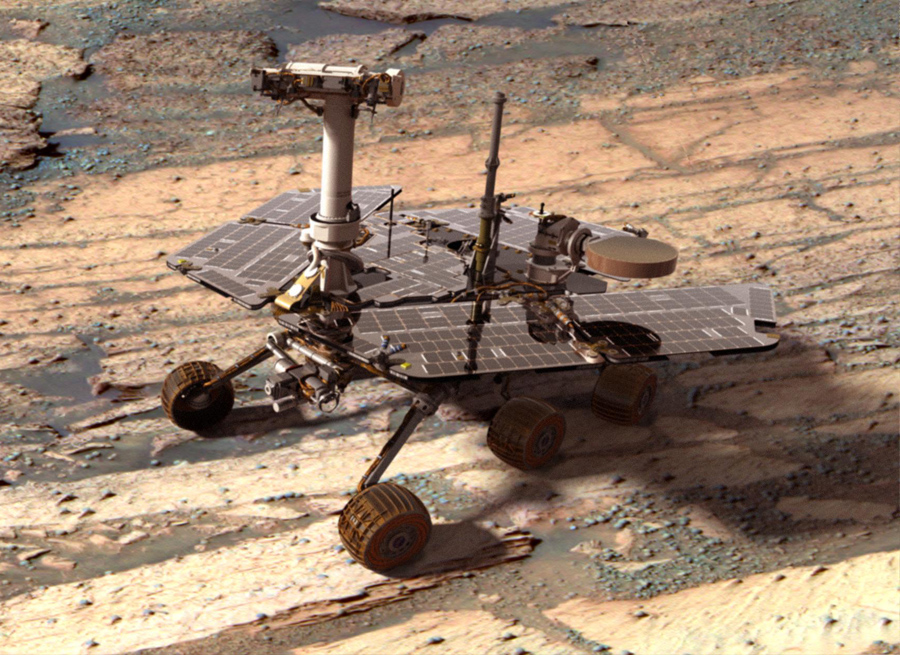
It's funny that for the sake of technical persuasiveness, the filmmakers placed on the roof of the rover an exact copy of a narrowly phased antenna array of direct communication with the Earth of the Curiosity rover.
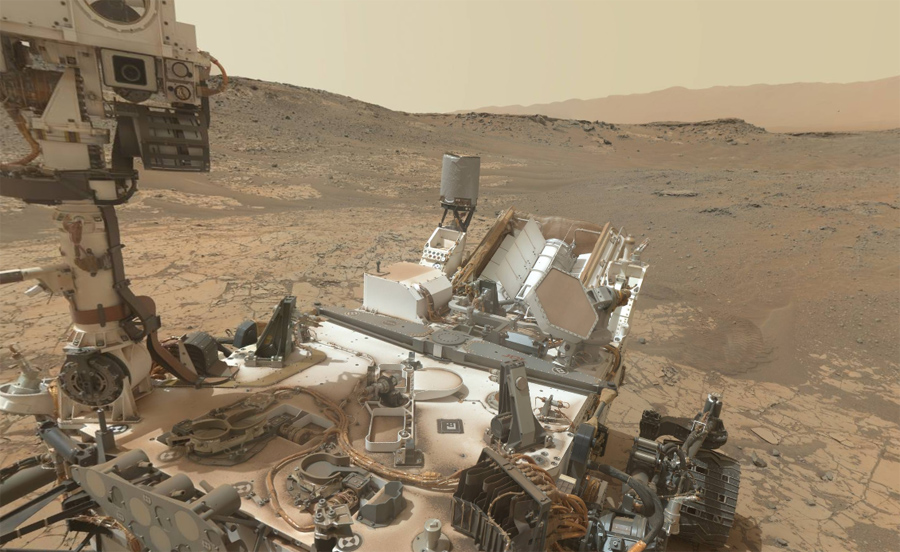
Those. if Mark had used it, there would have been no need to drive a thousand kilometers to the Mars Pathfinder.
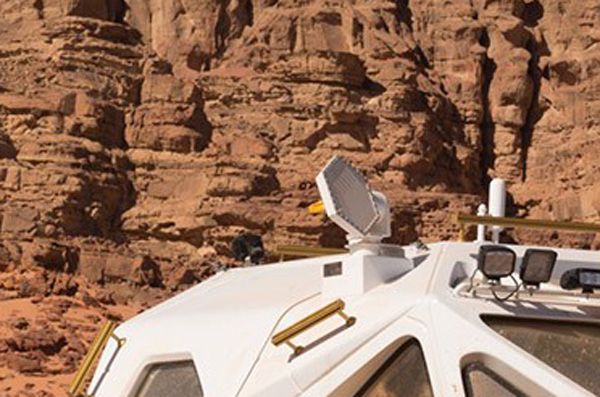
The forgetfulness of the hero of a book and a film about flying satellites above his head is also an omission. Even if he could not assemble a simple radio transmitter for communication with satellites, then nothing would prevent him from trampling “I'm Ok” near the base, or something else, given his sense of humor.

Optical imaging from satellites, by the way, is shown in the film quite convincingly. No myths with reading newspapers on the surface of the planet. The resolution of the images shown in the film roughly corresponds to the frames of the current MRO satellite and its HiRise camera . Although, I think if NASA decides to send people to Mars, it will take care of a more powerful device to increase the detail of images.
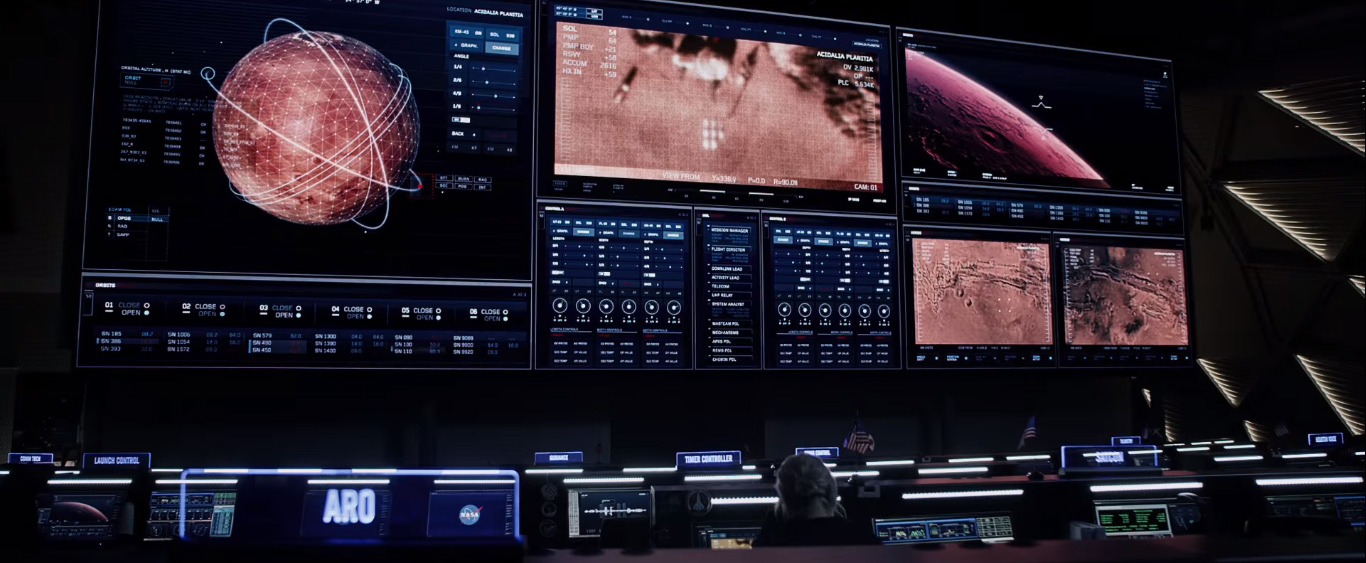
But the work of the satellite operator in the same Houston MCC, from which the manned mission is controlled, is a fairy tale, moreover, shown only in the film. The book tells about another department. In reality, the work of the MRO is controlled by the Arizona Institute, which runs the HiRise science program, and is controlled by a satellite from the JPL MCC in Pasadena California.
Let's go back to the Martian rover.
At the moment, all wheeled vehicles that have been on the Moon and Mars had hard skeleton wheels. How appropriate is the use of inflatable balloons on Mars is still an open question. It is clear that robotic Mars rovers are unable to perform tire fitting to pump up a flat tire, so there is no other way, but the rigid structure does not always justify itself.
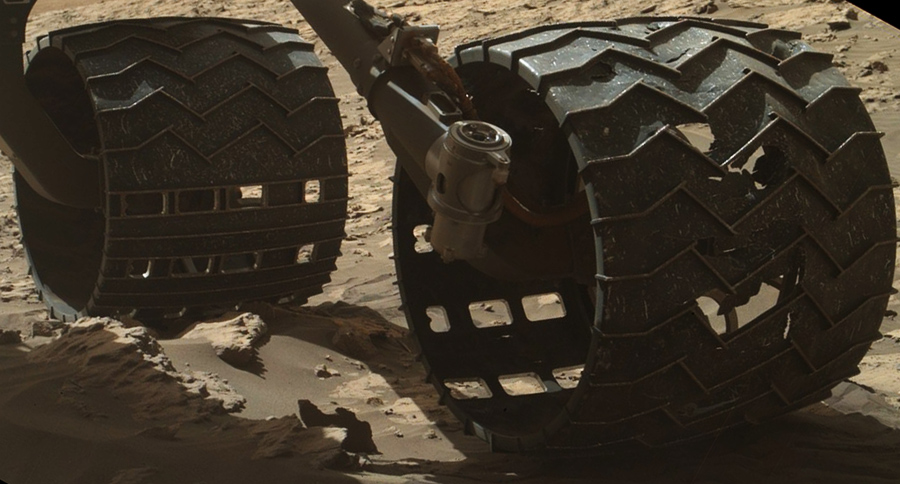
On the other hand, aluminum is much more resistant to daily temperature extremes, vacuum and solar ultraviolet. Even if we assume that a version of Martian rubber will be developed, it is more likely that the wheels will not have an inflatable, but a frame structure that is not afraid of punctures and gas leaks.

The habitable compartment of future manned rovers will most likely be different from that shown in the film. At the Martian, the Mars rover is a pickup SUV. In reality, a mobile home or laboratory would be more justified on Mars. Less adapted to storm off-road and more - to leisurely careful movement from one investigated area to another.


A "motor home" would be better suited for heating using an RTG. The small volume of the cinema rover instantly turned into a sauna when the device was brought in, because the temperature on the radiator blades reaches 200 degrees Celsius.
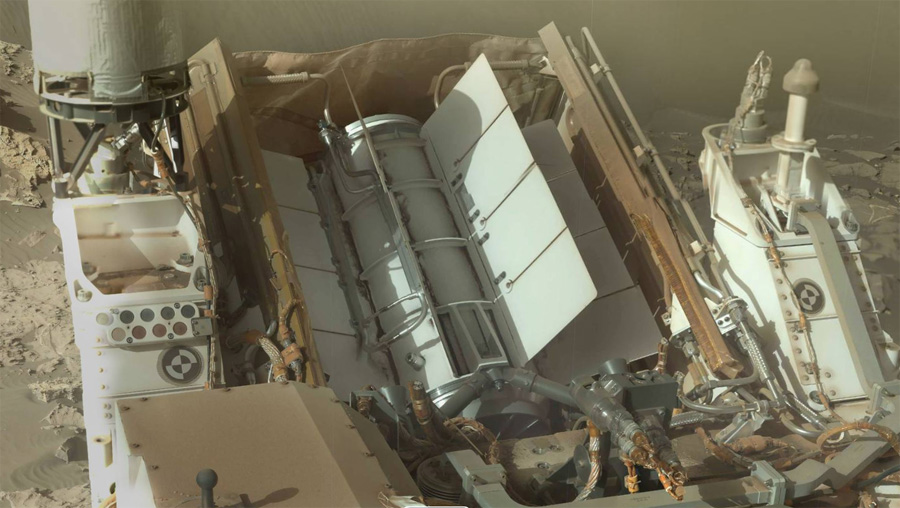
There were still questions about radiation from the RTG: how long could an astronaut sitting in an adjacent seat could stretch out? In principle, the generator on Plutonium-238 should not be very loud . At least people work with them without lead gowns.

2.5 mm lead is sufficient for shielding neutron and gamma radiation, therefore, usually, the RTG housing is enough, and in the film Mark wrapped it in a multi-layer screen-vacuum thermal insulation (this would lead to generator overheating, but now we are discussing the issue radiation). In short, theoretically, really, but the accumulated dose would still increase.
The motor resource of rovers of hundreds of kilometers without maintenance and service is entirely on the conscience of the author. Actually now the rover robots in total barely surpassed the mark of 55 km in 12 years. On the other hand, the Apollo 17 astronauts dashed off 35 km in two days, so that could be ...
Let's finish the review of the rover with an amusing detail. If you look closely at the wheels, you will see that their design is borrowed from real vehicles.

At the same time, in reality, these spiral plates on Spirit and Opportunity wheels have practical significance - they act as springs. For the “Martian,” these are just fashionable wheels.
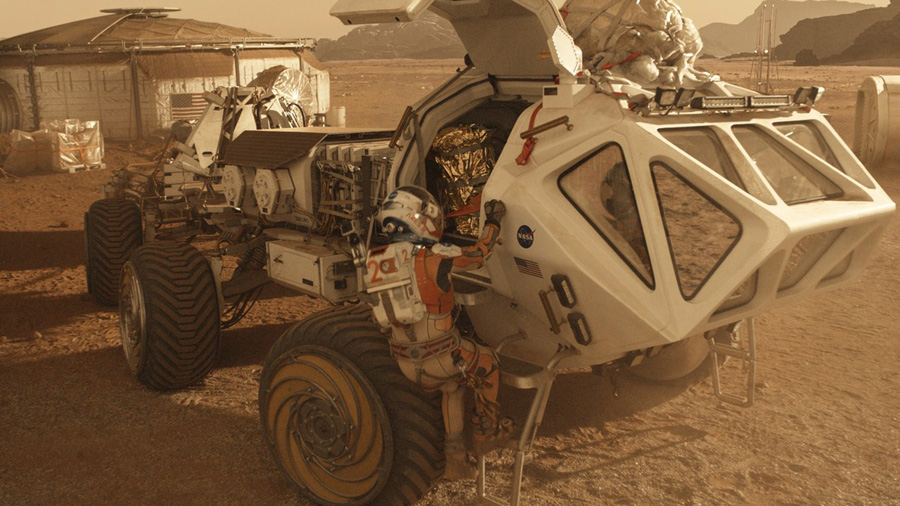
The 1997 probe Mars Pathfinder was a real movie star - he managed to star in two films, but like Sean Bean, he had to die in both cases - to give details to provide communication for the lost people.
True, in the Red Planet its location was reconstructed with much greater detail.
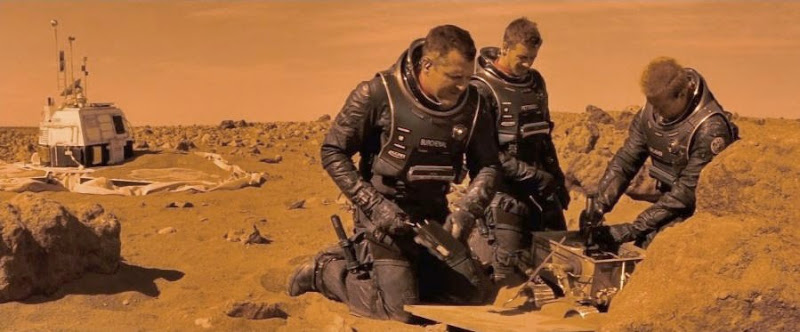
In the "Martian" we see a completely different area, much more suitable for overcoming wheeled vehicles.
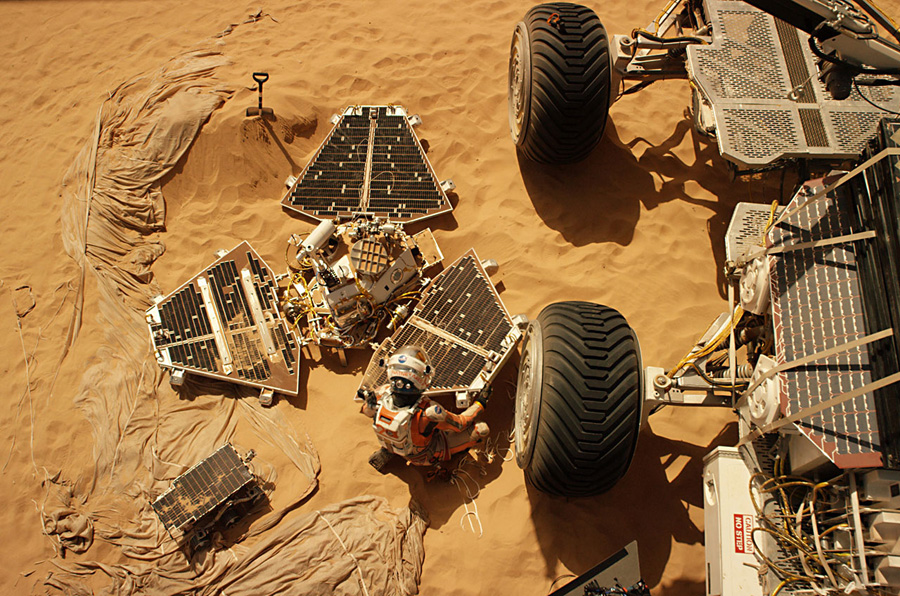
Of course we don’t know what the terrain will be like in 30 years, maybe an unknown climate change will drive sand blockages. But 10 years after planting, this rocky plain did not change its appearance much.

Of course, the 1996 spacecraft has no technological connectors compatible with the interfaces of the 2040s.
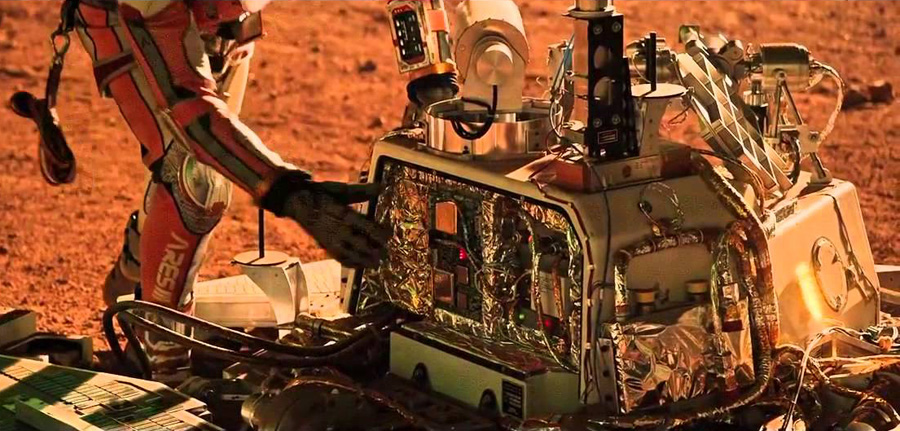
A very shameful mistake was made by the filmmakers when they decided to send humanitarian aid to Mars. The authors somehow did not think that a cargo ship adapted for docking in low Earth orbit and a capsule for soft landing on Mars would be different.

Therefore, when the movie shows a dramatic moment of the destruction of a rocket over Cape Canaveral, do not worry. Even if the rocket coped with the task, this capsule would collapse in the sky of Mars, because it is completely unsuitable for landing. In the best case, Mark Watney would have to collect jars of canned meat across the Martian desert with an area of hundreds of square kilometers.
In reality, a rescue probe with food would look something like this:

Although the orbital module in the film is quite authentic and resembles Cygnus from Orbital Science.

If we talk about the Martian take-off rocket, then it is more or less convincing. Most likely the rocket will be on hydrazine or solid fuel, because They are more suitable for long-term storage. Previously expressedlocal fuel production ideas: oxygen and methane in theory can be obtained from the Martian atmosphere, but their accumulation and storage in a liquefied state will be too complex and energy-intensive task, impossible by automated means.
But the ship, in which people rise from Mars, is somehow strange. For some reason they made him flat. This form would be more suitable for landing, and not for takeoff - to slow down in the upper atmosphere. Then the armored shield would be useful, only at the bottom, and not the nose. Even on Earth missiles, fairly light fairings are used, so there is no practical sense in welding a sewer hatch to the bow of a Martian ship. If only for ballast.
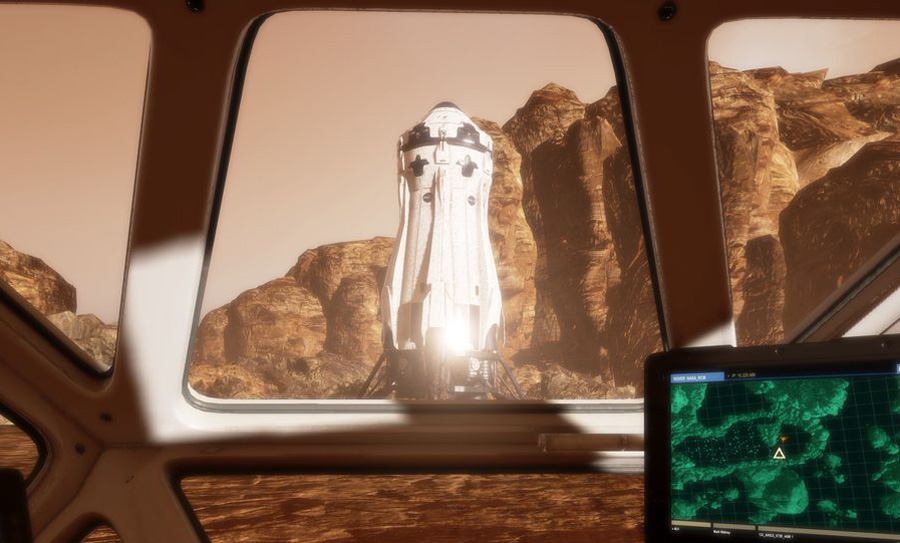
It’s hard to say about the flight “in a convertible”. On the one hand, the density of the Martian atmosphere at the surface is already as high as 35 km above the Earth, so the atmosphere is not a serious obstacle. On the other hand, when starting from Earth, rocket fairings are fired off at an altitude of 80-100 km, i.e. somewhere equivalent to the heights of 50-70 km of Mars. Therefore, the idea of flying with an open window is very risky.
In the same way, it is unlikely that a rocket, the main task of which is to push the crew to orbit, will have a set of spacesuits for going into outer space.

Now the spacesuits for flying in a ship are very different from those in which they go into outer space.

The task of the "internal" spacesuits is to ensure the pilot's survival for several minutes in case of depressurization of the ship. The suits for extra-ship activity are heavier and more difficult several times - these are practically autonomous spacecraft for work for hours.
In long-distance expeditions, the use of a two-in-one spacesuit is also possible to save weight and space. Such were on the lunar crews. The difference between the “room” and the “street” was only in the “hat” and “galoshes” that were worn before going to the surface.

The spacesuits of the Martian contradict both logicians. It was easier for Mark to fly in the same that was used on Mars, as his crew, in fact, did.

But then the Iron Man method would not work, with the release of gases from the internal volume of the spacesuit. This is a profanity, which the director introduced to increase the drama of the moment. In the book, Mark Watney listened to the commander and abandoned the idea of turning into a funny uncontrollable rocket top.
And finally, we will examine the migratory ship.
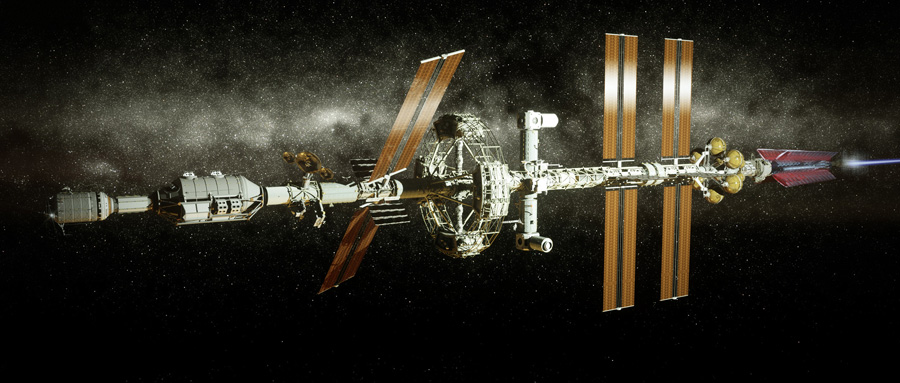
The concept, which is described in the book and shown in the film, is generally the most optimal and, most likely, something similar will fly to Mars. The interplanetary spacecraft will indeed look like a space station, and indeed, the use of electric rocket ion or plasma engines is most justified, although there will likely be VASIMR or equivalents. Only the use of a rotating compartment is unlikely.
What looks strange in the film is the ship's power source. The attention of the viewer is attracted by large solar panels, obviously copied from the ISS. At the same time, radiators more characteristic of a nuclear reactor can be seen in the area of the engine compartment. True for the reactor, their size will be required ten times more.
Apparently, it is assumed that the living compartment is powered by batteries, and engines from the reactor. But for real cosmonautics such a division is uncharacteristic. One power source is more rational: a nuclear reactor is able to provide power to both living compartments and engines, but batteries will not be able to power the engine, i.e. full duplication to improve reliability does not work. For example, it never occurred to anyone to put an RTG on a satellite or a rover, along with solar panels. There was a radioisotope source of energy on Lunokhod, but it worked only for heating.
True, in the concept of the Transport and Energy Module from Roscosmos, both solar panels and a reactor are visible, but here the auxiliary role of batteries is immediately noticeable.

Another feature of the migratory ship from the film excited the developers of the new Russian manned spacecraft PTK NP (Federation) to the core. Their thought is expressed by the question: "Why is there so much space?"

In the development of the Russian interplanetary ship, they are used to using every free cubic centimeter of space, and here at least play volleyball.
However, the ISS is more spacious, but you will have to search for bare walls there too.
The gym on the Hermes ship also amused the astronauts. In reality, only one is used in orbit, but a multifunctional power simulator.
Manually docking a cargo ship is not so fantastic. At least one precedent was when the Shuttle crew manually caught the Intelsat VI satellite.

Now on the ISS US segment, a manipulator is used for the same purpose. Autonomous docking of ships is only on the Russian segment.
At the end of the review, I would like to say that despite all of the above inaccuracies, fantasies and "directorial discoveries", the "Martian" is perhaps the best illustration of the foreseeable future of astronautics in scientific and technical terms.
